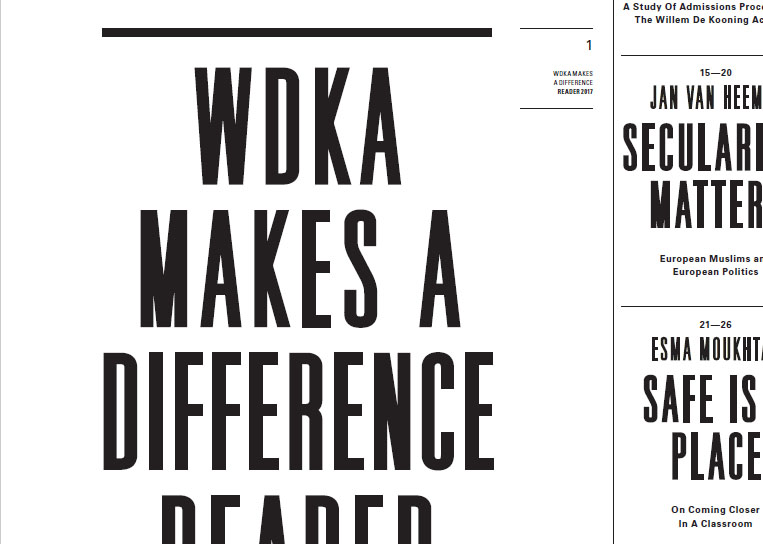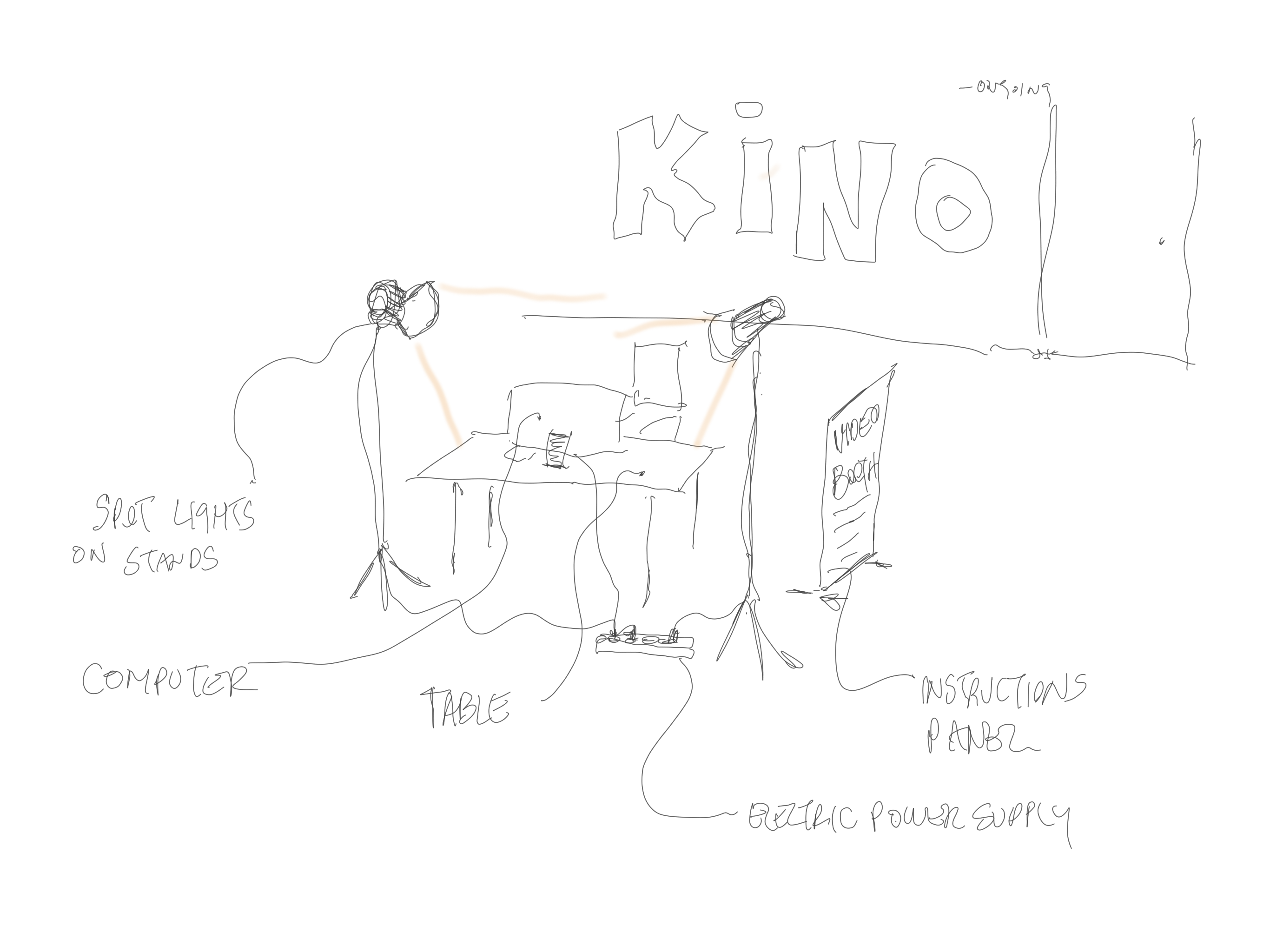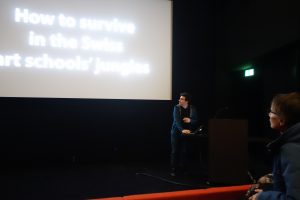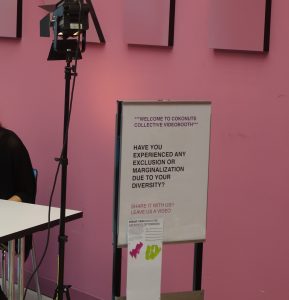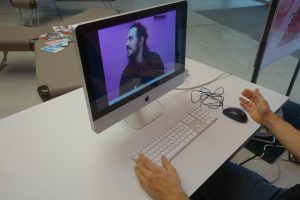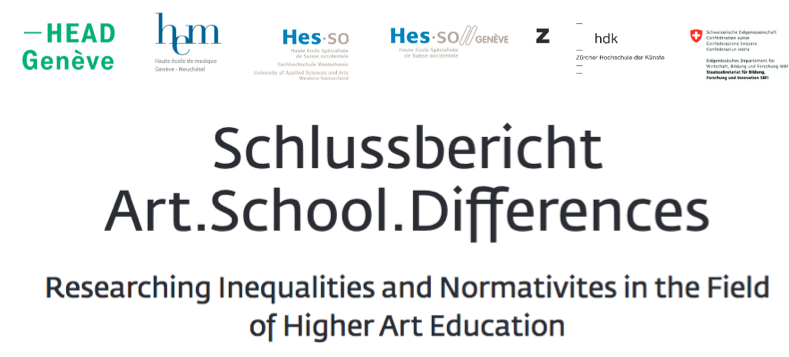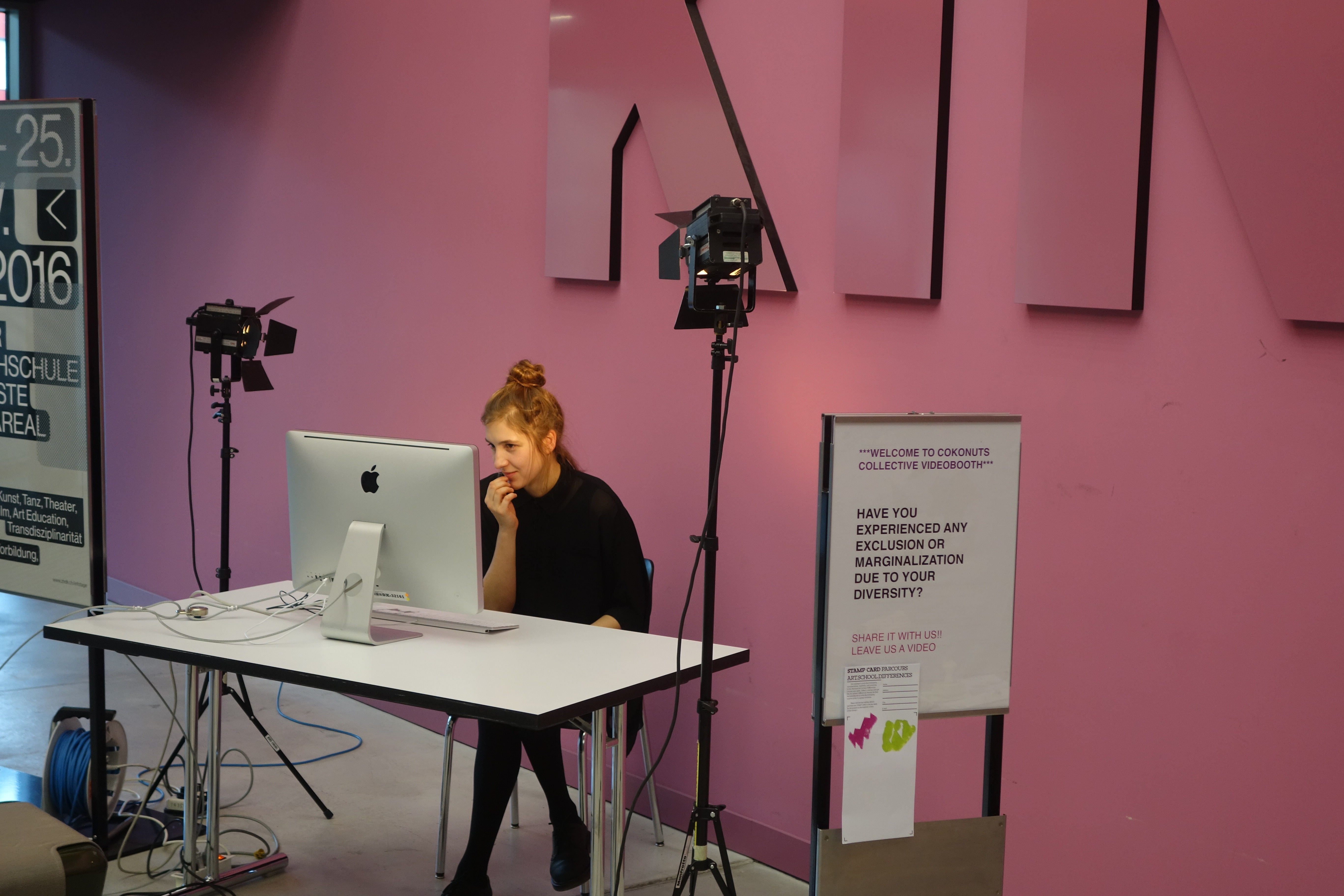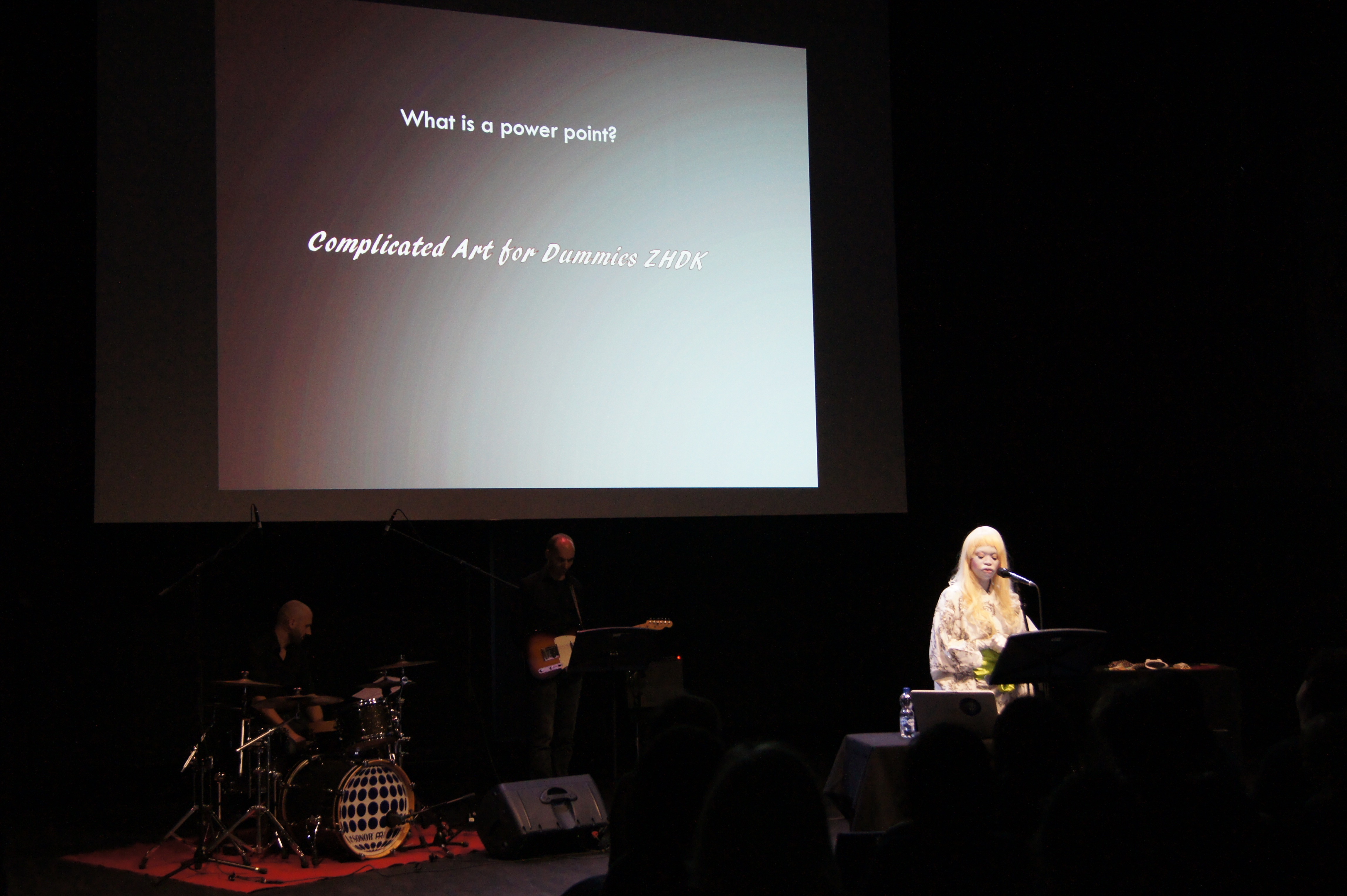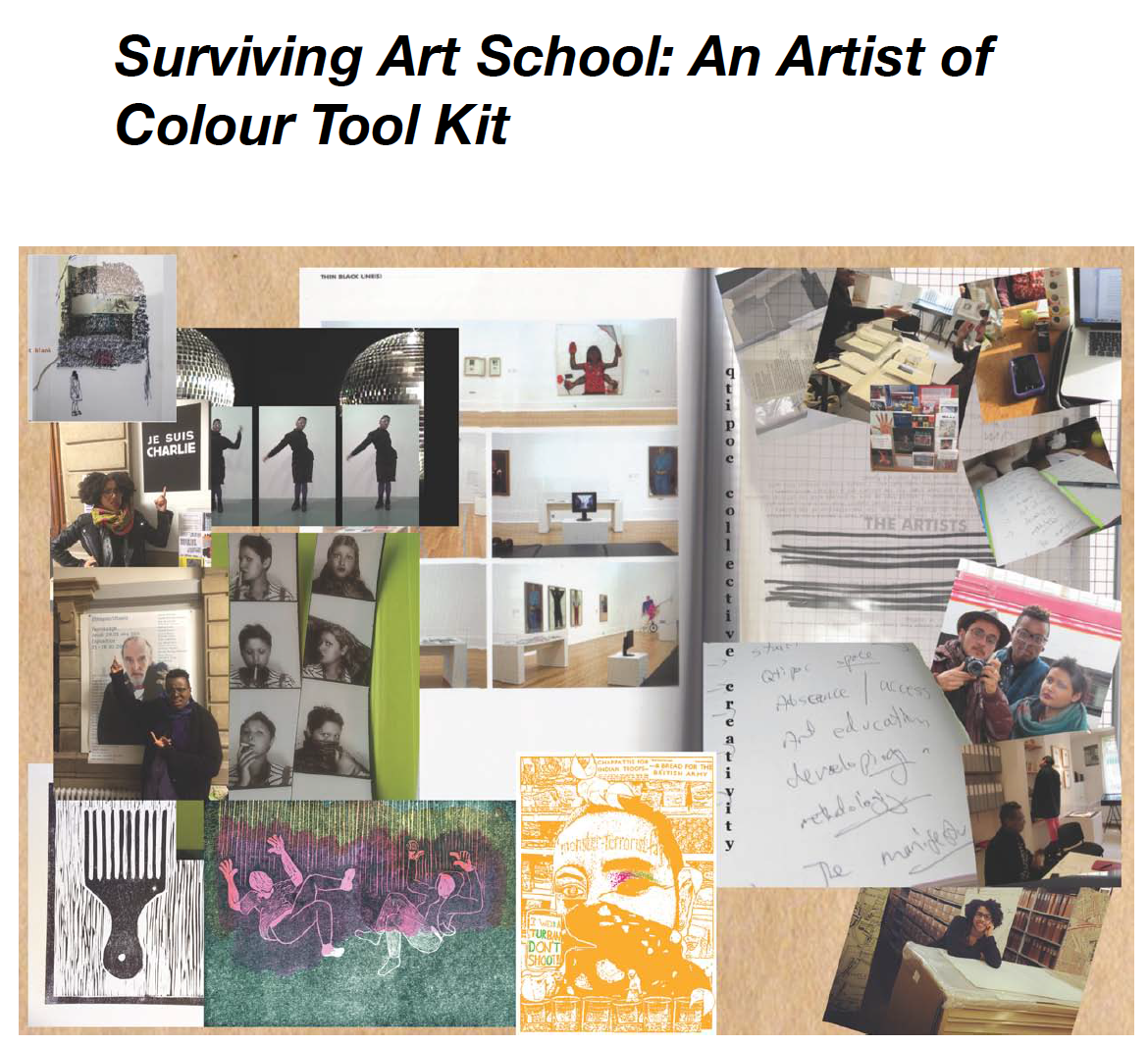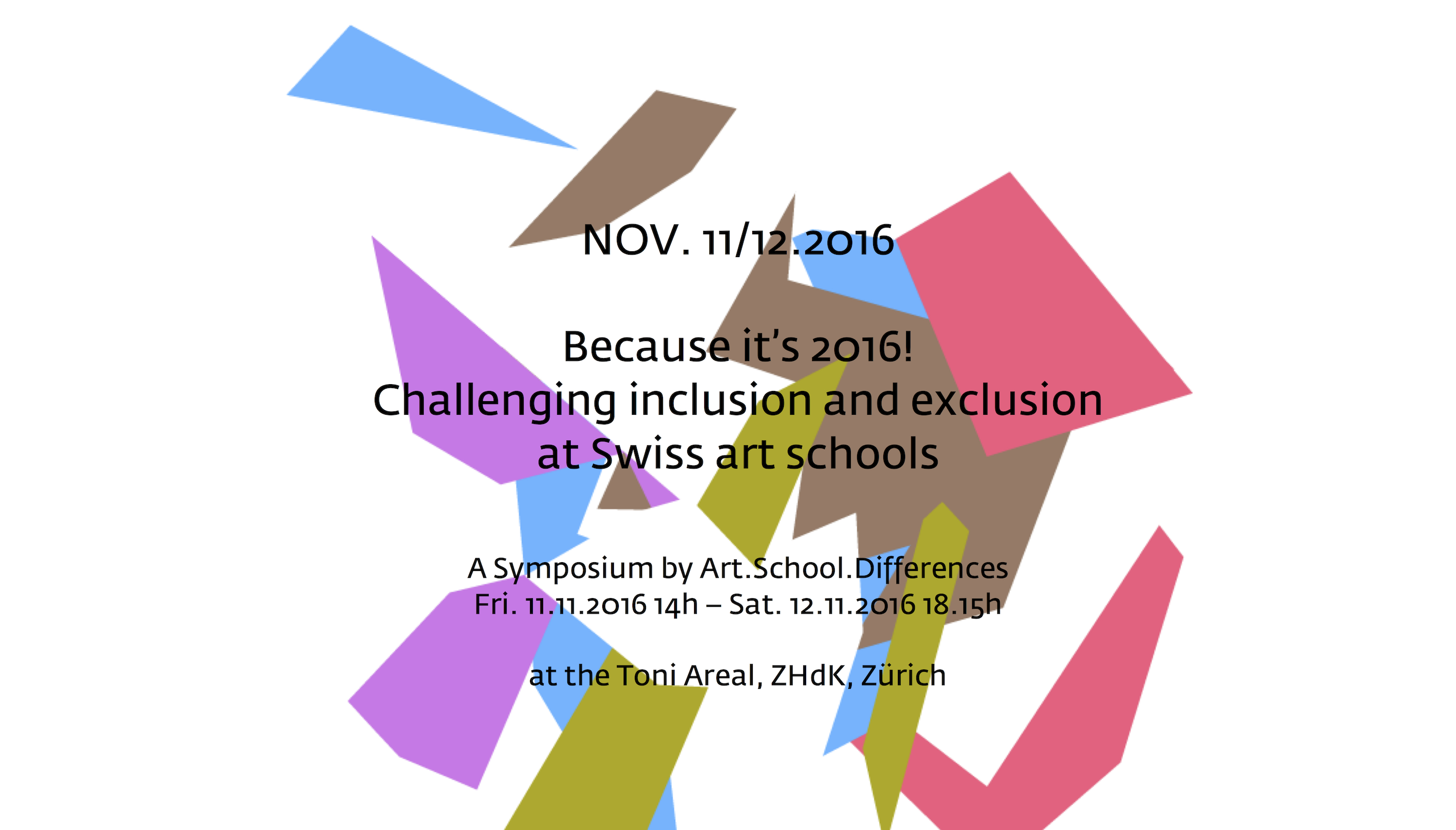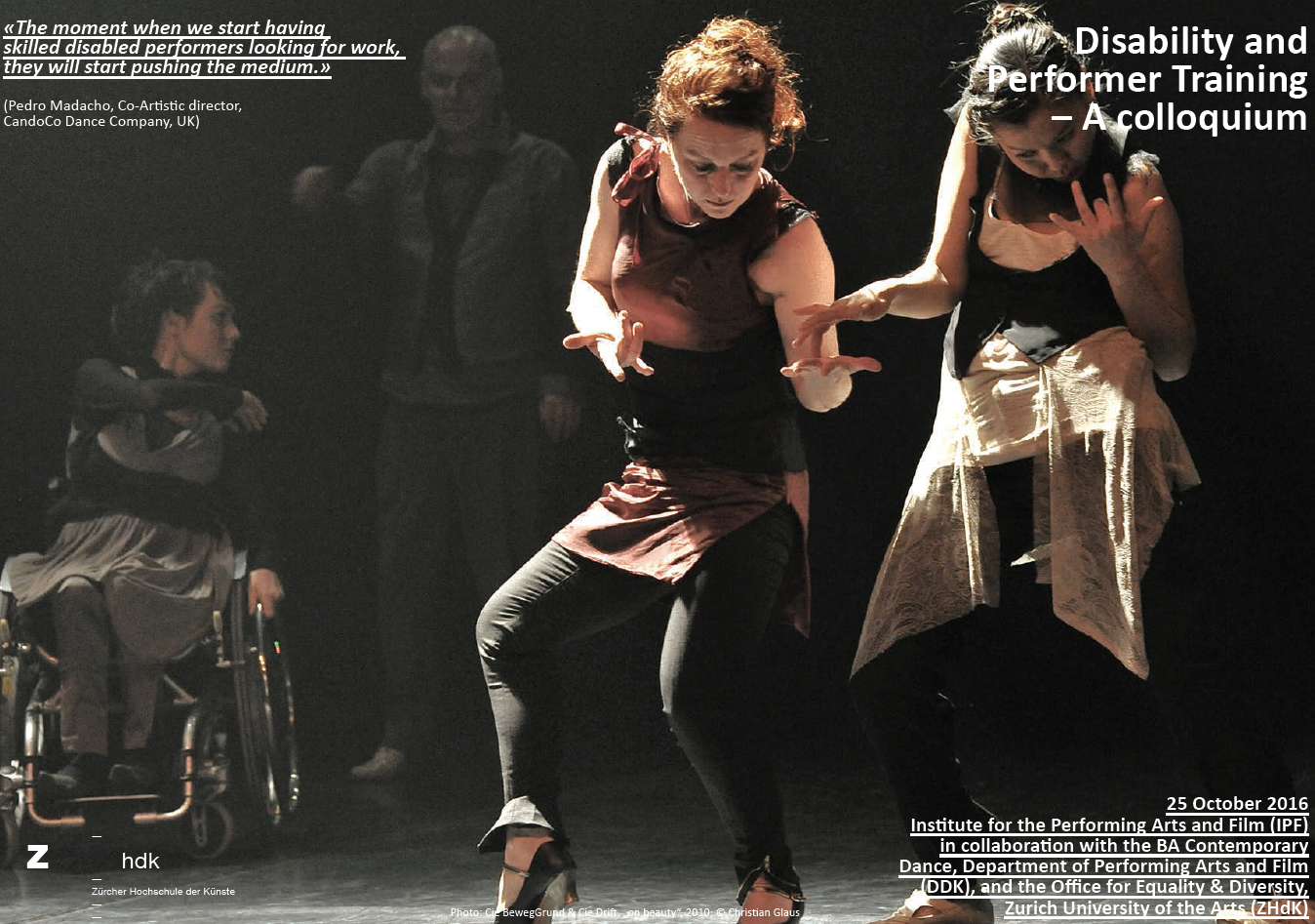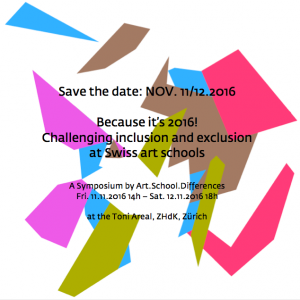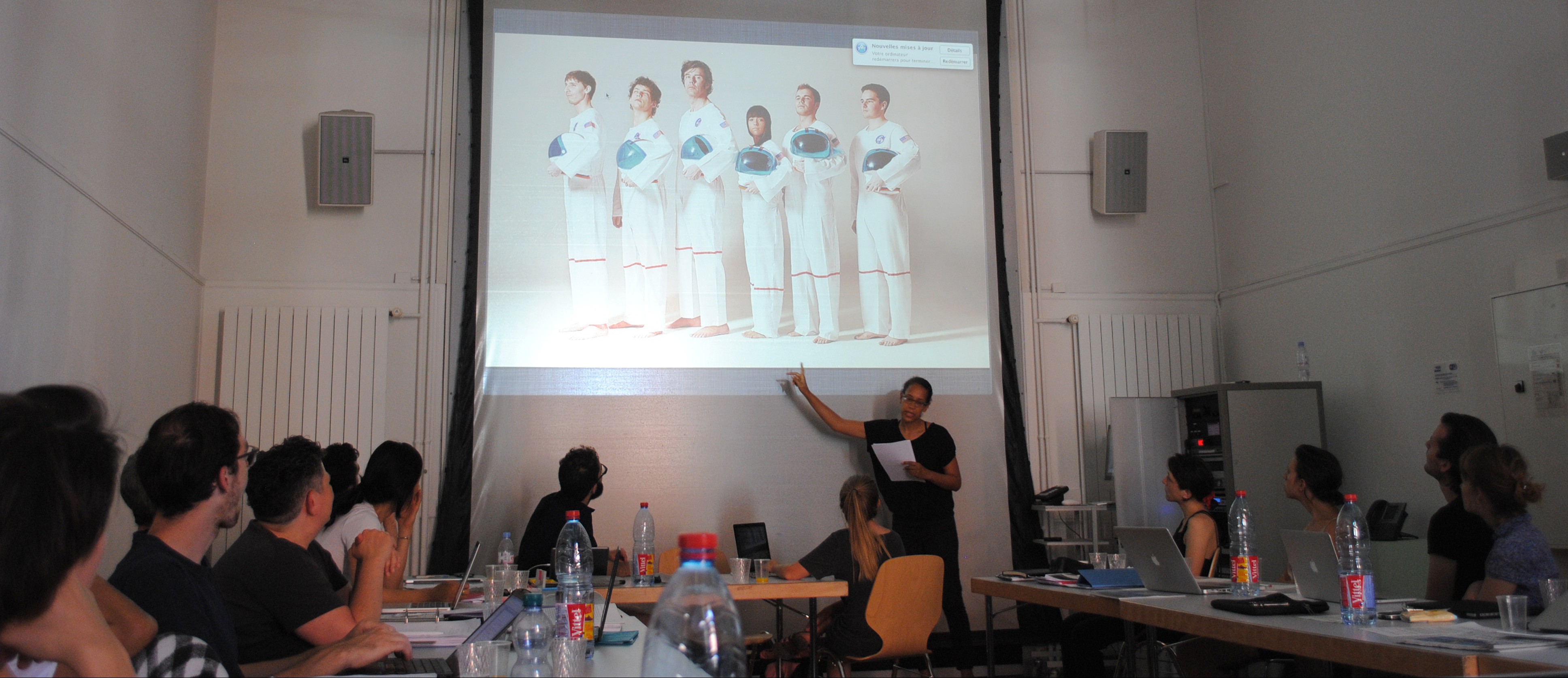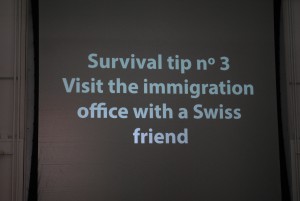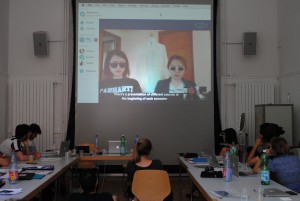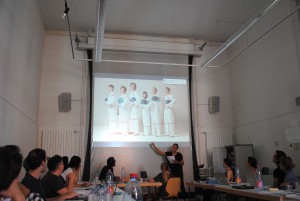REPORT ON THE FINAL ART.SCHOOL.DIFFERENCES SYMPOSIUM by Nina Mühlemann*
I attended the Symposium ‘Because it’s 2016! Challenging inclusion and exclusion at Swiss art schools’ as someone with a strong interest both in the performing arts and in disability inclusion. Growing up as a wheelchair user in Zurich and studying English and German literature in Basel, a critical analysis of disability or its representation was never part of the curriculum alongside gender, race or sexuality, even though I longed for theoretical frameworks that included disability. Once I discovered Disability Studies and realised that this was an emerging field in the UK and the USA, I decided to pursue a Master’s degree in the UK. Currently I am writing my doctoral thesis at King’s College London about the vibrancy of disability arts in the UK. When I arrived to do my master’s degree in London in 2010, I was amazed and delighted to discover the high professional standard of disabled artists in the UK in all art fields. Often, this work gives profound insight into different ways of being in the world and how we, as a society, value them.
I was very curious to hear at the Symposium what the situation is like in Switzerland for young disabled people who are keen to become professional artists. Where do Swiss art schools stand at the moment when it comes to inclusion? What are the barriers, and how can they be removed? What kind of insight can experts give who have been working in the field or art school inclusions all over the world? What can we learn from their experiences? This report will be written from a perspective that focuses on how disability was addressed during the Symposium, and I will attempt to insert disability into some of the questions or issues that were raised during those two days.
The day at ZHdK started off with Sophie Vögele, Philippe Saner, Pauline Vessely and Carmen Mörsch presenting their research on social differences in the admission process at Swiss art schools. The participating schools were the Zurich University of the Arts (ZHdK), the Haute école d’art et de design – Genève (HEAD – Genève) and the Haute école de musique Genève – Neuchâtel (HEM).
The researchers took a report from the UK as a starting point, Jackie McManus’ study ‘Art for a Few’, which stated that art schools are for the privileged, people who are white and middle-class. The researchers were then interested to find out how art schools in Switzerland recruit, evaluate and select their candidates – what is the ‘ideal student’ in this process, and furthermore, how do students cope with the idea of this ‘ideal student’? Are there any mechanisms that effect the exclusion of very specific social groups? In their results, they found, for example, that more and more students of artistic disciplines have at least one parent with a university degree and come from culturally privileged families.
When it came to presenting fields of tensions within the selection process at art schools, the group stated that the criteria this process is based on is often very vague, which in theory could open up a space for the unexpected, for students who are ‘other’ – yet, this was not what the researchers found, on the contrary, a normative identity seems to remain a requirement.
When it comes to disability, in particular, one finding was difficult to swallow: During the open days at ZHdK for the degrees in theatre and dance, it has been stated very openly by the art school that a normative physicality and mental wellbeing is a requirement for admission. This requirement is stated publicly, which perhaps shows that discrimination of disabled people is still something that happens very openly in Switzerland. In other parts of the assessment it is also made clear that it is a requirement to be in full physical and mental health to be able to do this degree. Why is this still acceptable? The title of the evening was after all ‘Because it’s 2016!’, and that such open discrimination in 2016 is still possible made me feel furious. It also made me feel extremely grateful that this research project and the rigorous work of the researchers was there to uncover this discrimination, put it on the table and offer it up for discussion.
Many of the rigorous requirements in traditional arts training are tied to able-bodiedness – Can students practice day and night? Can they mould their bodies for their artform in a way that makes their identity disappear? Can they adapt themselves and their artwork to whatever ideal their teachers or the market demands from them? All forms of perceived difference that deviate from a fabricated normative ideal are seen automatically as lesser, as not good enough.
Not demanding compulsory able-bodiedness from students would mean to let them mould the artform so that it suits their bodies and competences, not the other way around. As disabled artists in the US and in the UK have shown repeatedly, opening up art forms – dance, theatre, visual arts, performance – to disabled bodies can enrich these art forms and release new creative possibilities. This does not mean that whole curricula have to be changed, but it does demand a more flexible approach towards assessing students’ competences and a willingness to imagine a potential that goes beyond the already familiar from teachers and admission officers. It requires a willingness of teachers to be taught by their students sometimes, too.
The researchers then gave us a little preview of the reader, which will be available from early 2017. It was created based on the findings of their research, and texts in English, German and French. The reader will have five volumes and one of them focuses on disability inclusion. The reader was created as a tool and resource for teaching, but also as a support for negotiations that happen within the sector of higher education.
After this first insight, we heard the first two keynotes, which were both fantastic. First on was Rubén Gaztambide-Fernández, with a talk entitled ‘Creation, Participation, and the Political Life of Cultural Production’. It centred around the idea of cultural production, and how it can be used. Within this rhetoric, artistic forms are understood as processes, taking material conditions, cultural contexts and social circumstances into account. What cultural production is currently granted the status of ‘the arts’? Gaztambide-Fernández explored how particular conditions are needed to achieve this status, and he wondered whether it was possible for us, as a society, to relocate or resignify what we mean by the arts and to destabilise the hierarchy that often structures what is seen as arts and what is not.
Gaztambide-Fernández explained that traditionally, but also in a neoliberal context specifically, the arts are often framed as a substance or medicine that can be injected and has transformative qualities, as a tool to civilise citizens and especially young people. As a result, what we understand as ‘the arts’ becomes trapped by its own rhetoric, being seen as something that maintains ‘European civilization’, or in other words, European cultural supremacy.
Although Gaztambide-Fernández did not mention this, the injection of arts as ‘medicine’ is highly visible within a disability context where art is often seen as a form of rehabilitation or therapy. While art of course can be therapeutic, in these contexts the produced art is often seen as of little value, simply because it was produced as a means of therapy.
The second keynote was by Nana Adusei-Poku, entitled ‘Everyone Has to Learn Everything!’. She was talking about her own experience as a researcher and teacher within higher education at Rotterdam University of Applied Science. She explained that while the general population of Rotterdam consists of 55% people of colour and 45% white people, she does not see this population reflected in her class rooms. Adusei-Poku introduced me to the concept of racial time with the example that up until some decades ago, books were first given to white schools and then handed down to black schools. This delay produced a knowledge gap. Currently, there is another knowledge gap produced by racial time at schools, as the core curriculum is always based on white history, while black history is deemed ‘elective’ and absent in the canon. Adusei-Poku sees her work as decolonising work and acknowledged that this work is uncomfortable as it is destabilizing hierarchies, and as such is often met with resistance.
Adusei-Poku further talked about her experience of caring for her white students as a black educator and the emotional labour that comes from discussing whiteness with white people. This kind of emotional work that educators take on themselves is extremely necessary and, at the same time, under-appreciated and devalued.
While Adusei-Poku voiced some frustrations about her role, as most often she can only reach those who are already willing to listen, her talk also showed how important it is for inclusion not only to happen on a student level, but also on a staff level, in order to provide an inclusive and stimulating environment to all students. To see some of the work Adusei-Poku has done and what she has achieved together with her students and allies was extremely inspiring and left me feeling very positive.
What followed after these two wonderful keynotes was somewhat disheartening and also a clear example of the resistance Adusei-Poku mentioned that her work towards inclusion is often met with.
It was now time for three directorate-members of the art schools participating in the study to respond to the findings of the report. Hartmut Wickert of ZHdK, Lysianne Léchot Hirt of HEAD – Genève and Xavier Bouvier of HEM Genève-Neuchatel started the discussion on a defiant note, with Bouvier stating that everything he was going to say would get deconstructed anyway as he was seen as ‘the voice of power’. Wickert expressed that he found the fields of action identified in the report disappointing and unsatisfying, as the school had to adhere to strict frameworks already given and that enacting change would be difficult. Léchot Hirt was prepared to claim more responsibility for the findings of the study in her answer, saying that results came as a shock to her as the institution considers itself as innovative, and the study proved a rigidity and a predictability of the institution that she did not realize was there.
In their responses, all three educators repeatedly brought up the marketplace and the standard the market expects from absolvents of art schools, suggesting implicitly that the market demands certain kinds of people, especially ones that are already privileged. Some statements also made it seem as if rigid policies implemented on a cantonal and national level made it next to impossible for the schools themselves to evoke change. The three educators also questioned the methodology of the study, which seemed to serve as a distraction to respond to the real issues the report had pointed out. As the discussion progressed it became clear that many in the audience, myself included, were dismayed by the reaction of the gatekeepers of these three institutions.
I appreciate the gatekeeper’s presence at the discussion, because this is not something that can be taken for granted, and it shows a readiness to listen. Léchot Hirt also stayed for most of the 2-day symposium, which shows a willingness to learn about the issues discussed and openness for change. I am also aware that there well may be instances where a lack of funding or rigidly imposed frameworks make it difficult for the schools to enact change. However, as I mentioned at the beginning of the post, when it comes to disability there has been the case of such discouragement towards disabled students that has come from the ZHdK itself that I know there are profound misunderstandings and shortcomings which need to be addressed urgently.
In the discussion Wickert brought up DisAbility on Stage as an example where a step towards inclusion had already been taken, a research project at ZHdK which “aims to foster a discourse on dis/ability within Swiss Art Schools and universities by questioning models of dis/ability in theoretical reflection, performing practice and education. It brings together a unique team with members from national universities, art schools, dance and theater companies, and festivals, by including the three major Swiss language regions.” I am very excited about this project, but also dubious whether it is enough to readdress the systematic exclusions of disabled performers that have been happening for decades at Swiss art schools. DisAbility on Stage aims to bring disabled artists and art students together to foster understanding and collaboration, but it does not change the fact that disabled students are discouraged to apply to ZHdK.
I voiced this concern in the discussion and was told that the curricula of the art programmes at ZHdK could not be changed overnight and yet again that the art schools depend on applicants who the market has a demand for. Several people furiously spoke out against this response – as someone pointed out, justifying your exclusions and ableism with the fact that the same thing is happening on ‘the market’ is not good enough, especially as other countries such as the UK have shown that a) including disabled students does not require a complete change of the curricula and b) there is a market for disabled artists.
Once the discussion round was over I felt angry and disappointed, but also hopeful and, once again grateful for the people who did this research and organized this symposium to address the inequalities their research brought to light. A very energetic performance by Ntando Cele finished the day on a quite provocative note – Ntando slipped into different roles and the show encompassed a monologue chock-full of dark humour and punk songs performed live on stage, all the while addressing the systemic racism present in the art world, but also in Switzerland generally.
This full-on day left me quite exhausted for the 9am start on Saturday, but the two keynotes were once again fascinating: Cornelia Bartsch talked about the gendered and queer spaces she found in the music of Bach, and the music included in her presentation felt wonderfully soothing after the highly emotional experiences on the day before. Rena Onat and Bahareh Sharifi discussed the current situation in Germany, where a recent political decision to let refugees into the country was accompanied with funding of cultural education for those refugees, even though a further art school education is most of the time not a possibility for them. Furthermore, they brought in examples of artists in Germany and elsewhere who have experienced racism and used these experiences to think through structures of support.
After the two keynotes, there was a parcours where different rooms invited us to engage further with some of the questions and issues raised in the keynotes and presentations. While I enjoyed the two rooms I visited, I really needed the time to properly digest all the input from the two days, and more importantly, to connect with other people who attended the symposium. This was one of the most gratifying insights from the symposium: It opened up a room where alliances could be voiced and built. Fields that work with identity can sometimes be a little inward looking. In disability studies, we sometimes think about disability without taking other markers of difference or intersectionality into account when in reality, it can be so productive to look outwards, to share our insights and to listen to the insights of others.
In the afternoon, Melissa Steyn gave the final keynote about the important decolonizing work she has done within education in South Africa, and then Adusei-Poku, Jackie McManus, Olivier Moeschler, Ruth Sonderegger, Melissa Steyn and Ulf Wuggenig in their capacities as International Advisory Board members did a conference wrap-up. They highlighted again how important this work of the report is, and that the resistance that was shown towards it showed how necessary it was to get the ball rolling. I was very glad that I attended the symposium, even if it was upsetting for me to be confronted with the findings of the report. I left the symposium on a hopeful note, feeling inspired about all the fascinating research I heard about, especially as I think it will have an impact on the way I approach the classrooms I am teaching in. I am very excited for the readers to be published and hope that this research has been an important milestone which will evoke change at Swiss art schools and beyond.
*Nina Mühlemann is a doctoral student and Teaching Assistant at King’s College London at the Department for English Literature. Her focus is to analyse works of disabled artists and compare them to mainstream representations of disability. The title of her thesis is ‘Beyond the Superhuman: Performing Disability Arts Around London 2012’.
